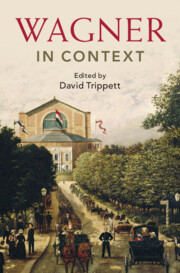Book contents
- Wagner in Context
- Composers in Context
- Wagner in Context
- Copyright page
- Contents
- Illustrations
- Musical Examples
- Contributors
- Acknowledgements
- Abbreviations
- Introduction
- I Place
- II People
- Chapter 9 Franz Liszt
- Chapter 10 Nietzsche and Wagner: The Logic of Contradiction
- Chapter 11 Wagner, Schopenhauer, and the World as a Phantasmagoria
- Chapter 12 Assessing Wilhelmine Schröder-Devrient: Influence, Genre, and Voice
- Chapter 13 Cosima Wagner
- Chapter 14 The Wagner Family: Rebellion, Honour, Aftermath
- III Politics, Ideas, and Bodies
- IV Life, Language, and the Ancient World
- V Music and Performance
- VI Reception
- Further Reading
- Select Bibliography
- Index
Chapter 12 - Assessing Wilhelmine Schröder-Devrient: Influence, Genre, and Voice
from II - People
Published online by Cambridge University Press: 14 March 2024
- Wagner in Context
- Composers in Context
- Wagner in Context
- Copyright page
- Contents
- Illustrations
- Musical Examples
- Contributors
- Acknowledgements
- Abbreviations
- Introduction
- I Place
- II People
- Chapter 9 Franz Liszt
- Chapter 10 Nietzsche and Wagner: The Logic of Contradiction
- Chapter 11 Wagner, Schopenhauer, and the World as a Phantasmagoria
- Chapter 12 Assessing Wilhelmine Schröder-Devrient: Influence, Genre, and Voice
- Chapter 13 Cosima Wagner
- Chapter 14 The Wagner Family: Rebellion, Honour, Aftermath
- III Politics, Ideas, and Bodies
- IV Life, Language, and the Ancient World
- V Music and Performance
- VI Reception
- Further Reading
- Select Bibliography
- Index
Summary
The German soprano Wilhelmine Schröder-Devrient had a profound influence on aesthetic ideals regarding vocal delivery and emergent genres for German commentators from Ludwig Tieck to Rellstab and Wagner. With a focus on contemporary biographical sources and reception, this chapter contextualises her reception within the German states as irreducibly hybrid, as a voice that dissolved aesthetic boundaries, most clearly between speech and song. The shifting role of bel canto vis-à-vis contemporary sopranos (Henrietta Sontag / Maria Malibran), and the emergence of new genres characterise her complex reception, all of which is set against Wagner’s own claims for her artistry, following her creation of the roles Adriano (Rienzi), Senta (Holländer), and Venus (Tannhäuser).
Keywords
- Type
- Chapter
- Information
- Wagner in Context , pp. 122 - 130Publisher: Cambridge University PressPrint publication year: 2024

